Communication Challenges and Solutions: A Business Report
VerifiedAdded on 2020/02/24
|13
|3711
|39
Report
AI Summary
This report analyzes the communication challenges faced by a multinational agricultural equipment manufacturing and distribution company operating in Australia, India, Oman, and Nigeria. The company, with over 8000 employees and a vast customer base, experiences issues like untimely communication, breakdowns from top management, feedback collection problems, language barriers, digital literacy gaps, and cross-cultural misunderstandings. The report highlights good communication practices, including adhering to the 7 Cs of communication (completeness, conciseness, consideration, clarity, concreteness, correctness, and courtesy), engaging in formal communication, emphasizing oral and written communication, documenting client interactions, and maintaining clear communication across all hierarchical levels. Furthermore, the report proposes future strategies such as establishing regular client communication, improving top-down and bottom-up communication flows, implementing feedback mechanisms, addressing language barriers through local language recruitment and a common platform like English, providing technology training, and fostering cross-cultural awareness through employee activities and respect for diverse viewpoints. These strategies aim to improve customer satisfaction, employee engagement, and overall organizational performance.
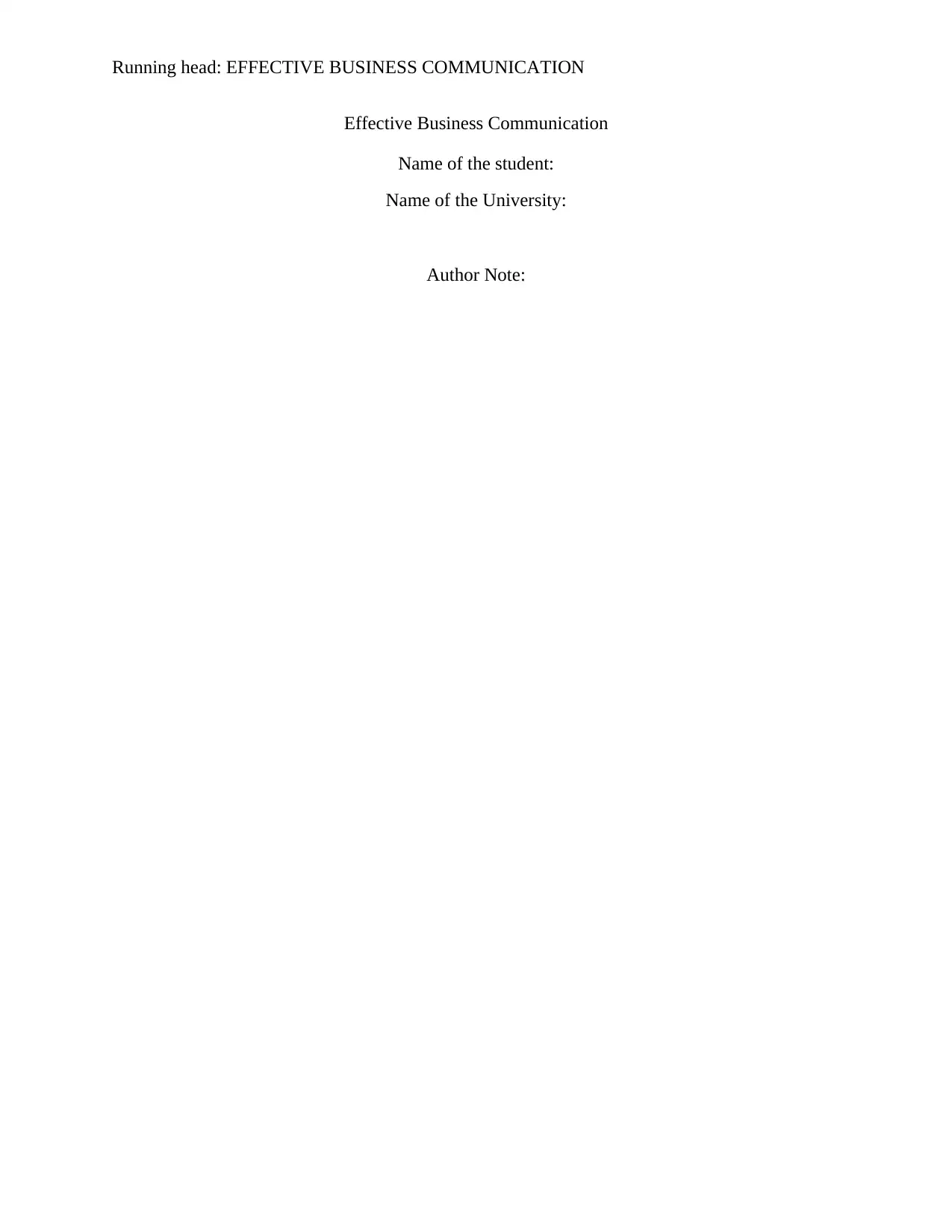
Running head: EFFECTIVE BUSINESS COMMUNICATION
Effective Business Communication
Name of the student:
Name of the University:
Author Note:
Effective Business Communication
Name of the student:
Name of the University:
Author Note:
Secure Best Marks with AI Grader
Need help grading? Try our AI Grader for instant feedback on your assignments.
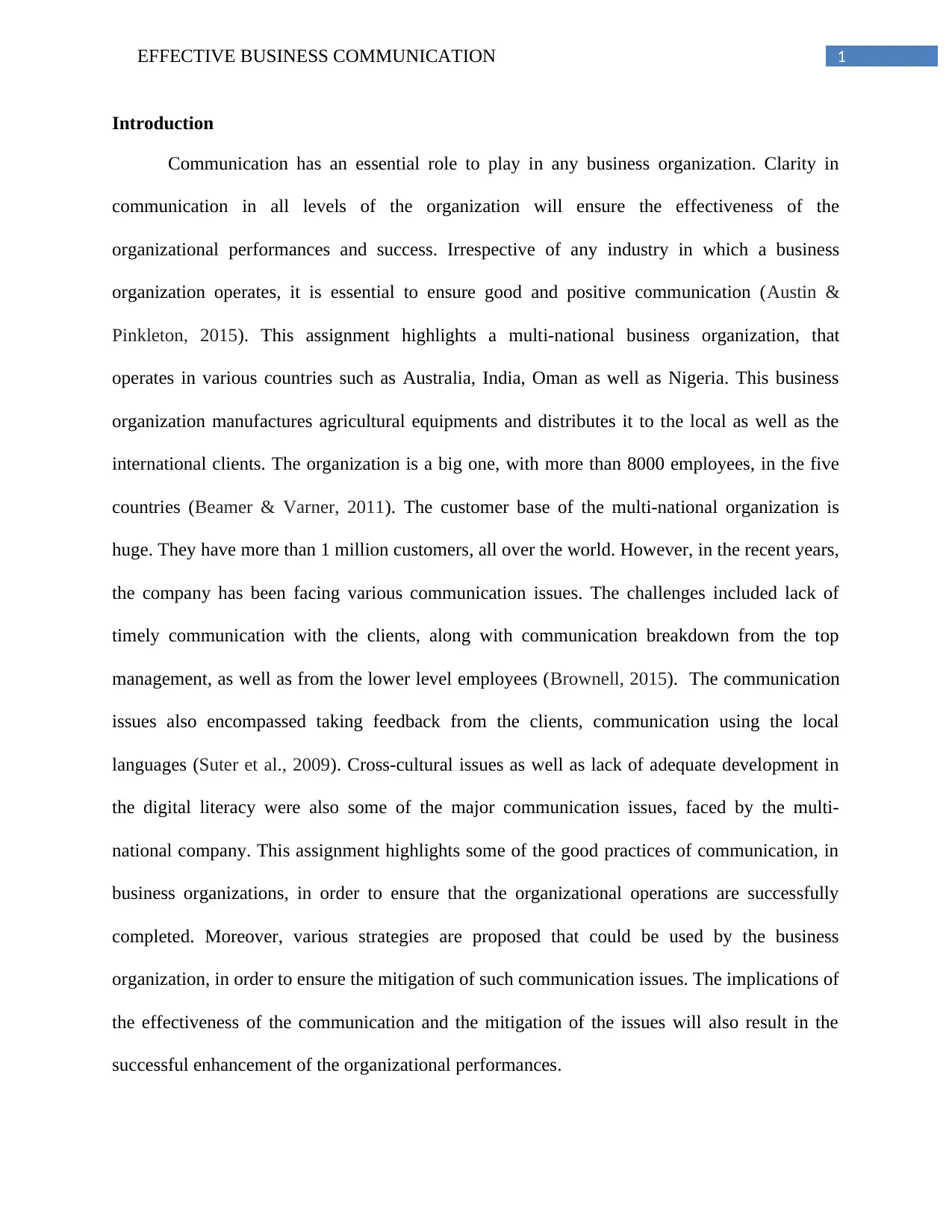
1EFFECTIVE BUSINESS COMMUNICATION
Introduction
Communication has an essential role to play in any business organization. Clarity in
communication in all levels of the organization will ensure the effectiveness of the
organizational performances and success. Irrespective of any industry in which a business
organization operates, it is essential to ensure good and positive communication (Austin &
Pinkleton, 2015). This assignment highlights a multi-national business organization, that
operates in various countries such as Australia, India, Oman as well as Nigeria. This business
organization manufactures agricultural equipments and distributes it to the local as well as the
international clients. The organization is a big one, with more than 8000 employees, in the five
countries (Beamer & Varner, 2011). The customer base of the multi-national organization is
huge. They have more than 1 million customers, all over the world. However, in the recent years,
the company has been facing various communication issues. The challenges included lack of
timely communication with the clients, along with communication breakdown from the top
management, as well as from the lower level employees (Brownell, 2015). The communication
issues also encompassed taking feedback from the clients, communication using the local
languages (Suter et al., 2009). Cross-cultural issues as well as lack of adequate development in
the digital literacy were also some of the major communication issues, faced by the multi-
national company. This assignment highlights some of the good practices of communication, in
business organizations, in order to ensure that the organizational operations are successfully
completed. Moreover, various strategies are proposed that could be used by the business
organization, in order to ensure the mitigation of such communication issues. The implications of
the effectiveness of the communication and the mitigation of the issues will also result in the
successful enhancement of the organizational performances.
Introduction
Communication has an essential role to play in any business organization. Clarity in
communication in all levels of the organization will ensure the effectiveness of the
organizational performances and success. Irrespective of any industry in which a business
organization operates, it is essential to ensure good and positive communication (Austin &
Pinkleton, 2015). This assignment highlights a multi-national business organization, that
operates in various countries such as Australia, India, Oman as well as Nigeria. This business
organization manufactures agricultural equipments and distributes it to the local as well as the
international clients. The organization is a big one, with more than 8000 employees, in the five
countries (Beamer & Varner, 2011). The customer base of the multi-national organization is
huge. They have more than 1 million customers, all over the world. However, in the recent years,
the company has been facing various communication issues. The challenges included lack of
timely communication with the clients, along with communication breakdown from the top
management, as well as from the lower level employees (Brownell, 2015). The communication
issues also encompassed taking feedback from the clients, communication using the local
languages (Suter et al., 2009). Cross-cultural issues as well as lack of adequate development in
the digital literacy were also some of the major communication issues, faced by the multi-
national company. This assignment highlights some of the good practices of communication, in
business organizations, in order to ensure that the organizational operations are successfully
completed. Moreover, various strategies are proposed that could be used by the business
organization, in order to ensure the mitigation of such communication issues. The implications of
the effectiveness of the communication and the mitigation of the issues will also result in the
successful enhancement of the organizational performances.
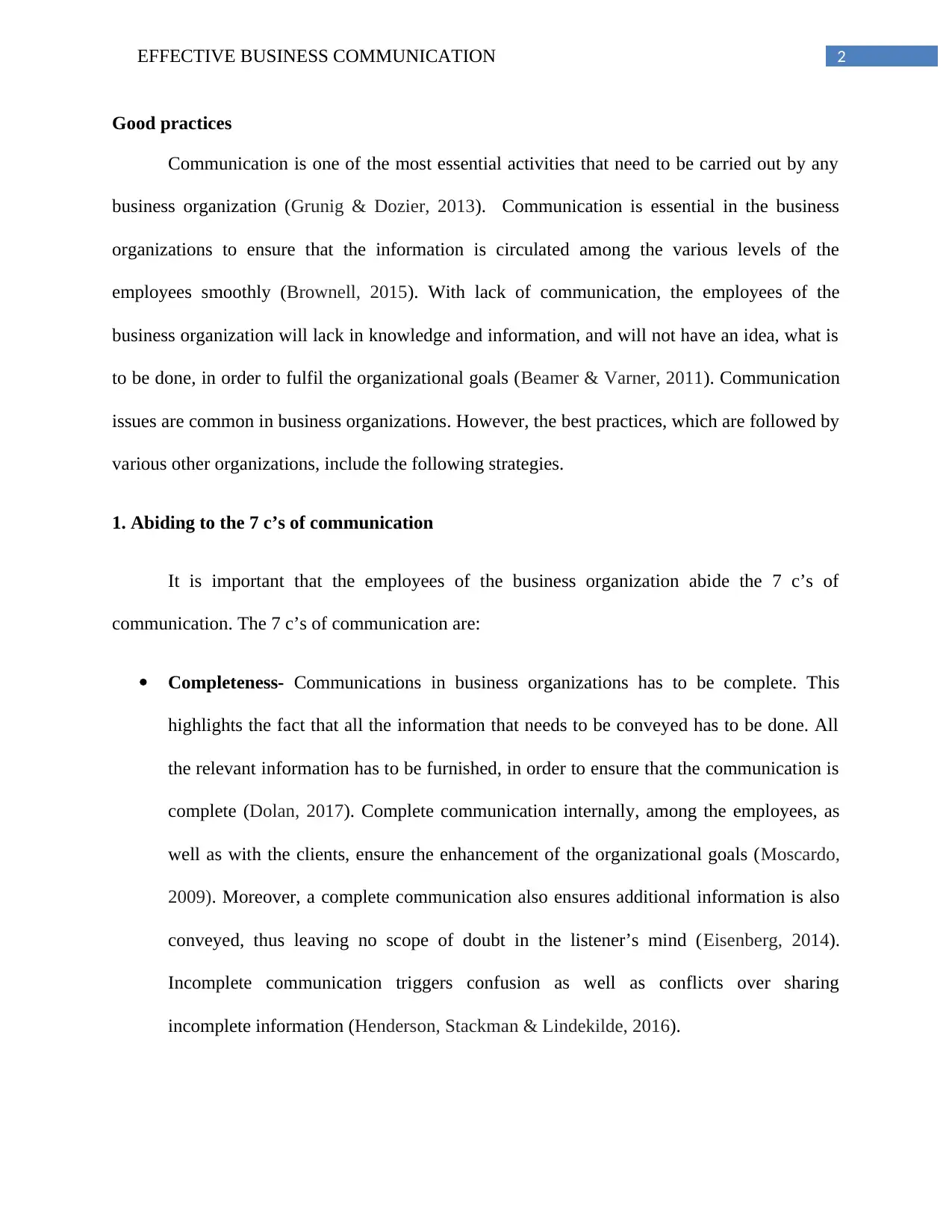
2EFFECTIVE BUSINESS COMMUNICATION
Good practices
Communication is one of the most essential activities that need to be carried out by any
business organization (Grunig & Dozier, 2013). Communication is essential in the business
organizations to ensure that the information is circulated among the various levels of the
employees smoothly (Brownell, 2015). With lack of communication, the employees of the
business organization will lack in knowledge and information, and will not have an idea, what is
to be done, in order to fulfil the organizational goals (Beamer & Varner, 2011). Communication
issues are common in business organizations. However, the best practices, which are followed by
various other organizations, include the following strategies.
1. Abiding to the 7 c’s of communication
It is important that the employees of the business organization abide the 7 c’s of
communication. The 7 c’s of communication are:
Completeness- Communications in business organizations has to be complete. This
highlights the fact that all the information that needs to be conveyed has to be done. All
the relevant information has to be furnished, in order to ensure that the communication is
complete (Dolan, 2017). Complete communication internally, among the employees, as
well as with the clients, ensure the enhancement of the organizational goals (Moscardo,
2009). Moreover, a complete communication also ensures additional information is also
conveyed, thus leaving no scope of doubt in the listener’s mind (Eisenberg, 2014).
Incomplete communication triggers confusion as well as conflicts over sharing
incomplete information (Henderson, Stackman & Lindekilde, 2016).
Good practices
Communication is one of the most essential activities that need to be carried out by any
business organization (Grunig & Dozier, 2013). Communication is essential in the business
organizations to ensure that the information is circulated among the various levels of the
employees smoothly (Brownell, 2015). With lack of communication, the employees of the
business organization will lack in knowledge and information, and will not have an idea, what is
to be done, in order to fulfil the organizational goals (Beamer & Varner, 2011). Communication
issues are common in business organizations. However, the best practices, which are followed by
various other organizations, include the following strategies.
1. Abiding to the 7 c’s of communication
It is important that the employees of the business organization abide the 7 c’s of
communication. The 7 c’s of communication are:
Completeness- Communications in business organizations has to be complete. This
highlights the fact that all the information that needs to be conveyed has to be done. All
the relevant information has to be furnished, in order to ensure that the communication is
complete (Dolan, 2017). Complete communication internally, among the employees, as
well as with the clients, ensure the enhancement of the organizational goals (Moscardo,
2009). Moreover, a complete communication also ensures additional information is also
conveyed, thus leaving no scope of doubt in the listener’s mind (Eisenberg, 2014).
Incomplete communication triggers confusion as well as conflicts over sharing
incomplete information (Henderson, Stackman & Lindekilde, 2016).
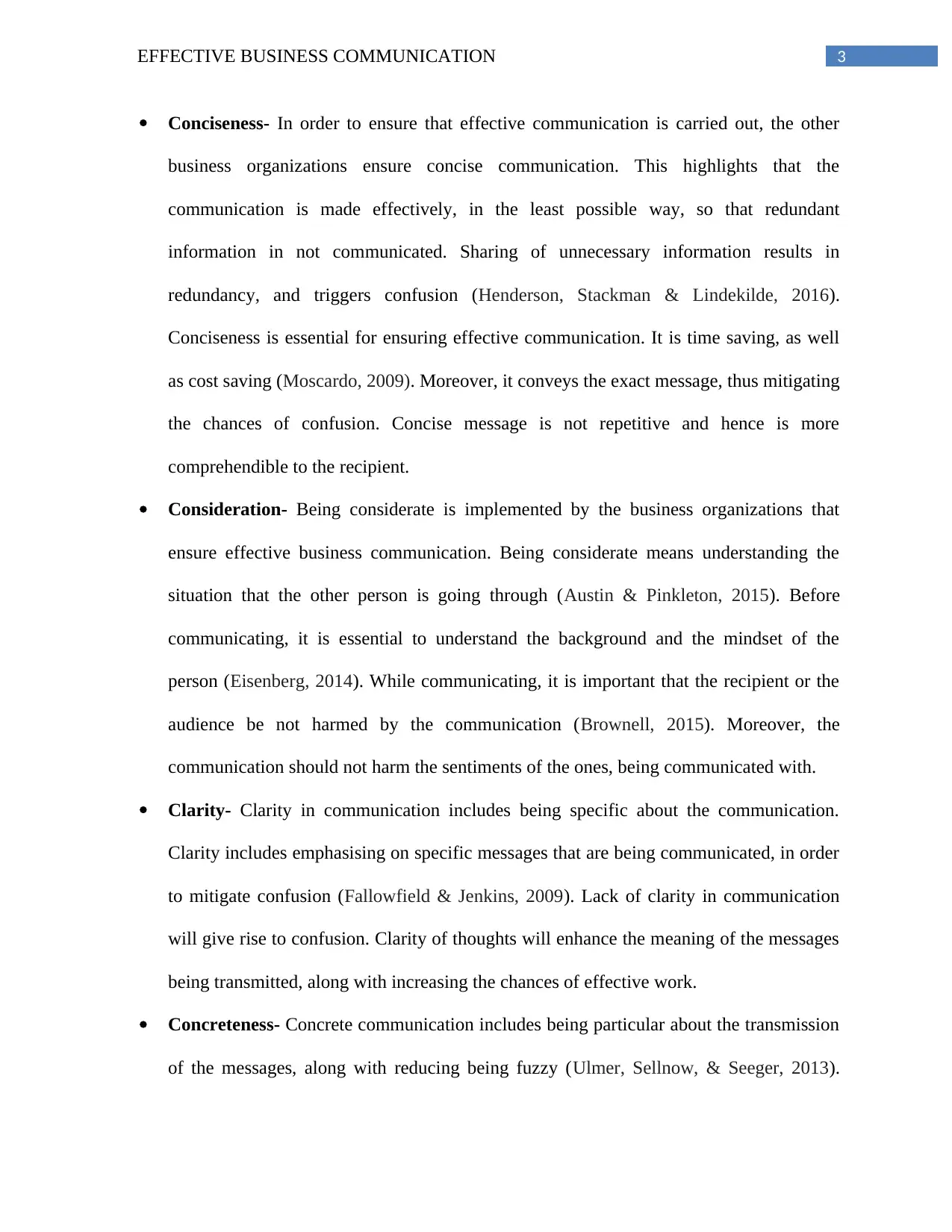
3EFFECTIVE BUSINESS COMMUNICATION
Conciseness- In order to ensure that effective communication is carried out, the other
business organizations ensure concise communication. This highlights that the
communication is made effectively, in the least possible way, so that redundant
information in not communicated. Sharing of unnecessary information results in
redundancy, and triggers confusion (Henderson, Stackman & Lindekilde, 2016).
Conciseness is essential for ensuring effective communication. It is time saving, as well
as cost saving (Moscardo, 2009). Moreover, it conveys the exact message, thus mitigating
the chances of confusion. Concise message is not repetitive and hence is more
comprehendible to the recipient.
Consideration- Being considerate is implemented by the business organizations that
ensure effective business communication. Being considerate means understanding the
situation that the other person is going through (Austin & Pinkleton, 2015). Before
communicating, it is essential to understand the background and the mindset of the
person (Eisenberg, 2014). While communicating, it is important that the recipient or the
audience be not harmed by the communication (Brownell, 2015). Moreover, the
communication should not harm the sentiments of the ones, being communicated with.
Clarity- Clarity in communication includes being specific about the communication.
Clarity includes emphasising on specific messages that are being communicated, in order
to mitigate confusion (Fallowfield & Jenkins, 2009). Lack of clarity in communication
will give rise to confusion. Clarity of thoughts will enhance the meaning of the messages
being transmitted, along with increasing the chances of effective work.
Concreteness- Concrete communication includes being particular about the transmission
of the messages, along with reducing being fuzzy (Ulmer, Sellnow, & Seeger, 2013).
Conciseness- In order to ensure that effective communication is carried out, the other
business organizations ensure concise communication. This highlights that the
communication is made effectively, in the least possible way, so that redundant
information in not communicated. Sharing of unnecessary information results in
redundancy, and triggers confusion (Henderson, Stackman & Lindekilde, 2016).
Conciseness is essential for ensuring effective communication. It is time saving, as well
as cost saving (Moscardo, 2009). Moreover, it conveys the exact message, thus mitigating
the chances of confusion. Concise message is not repetitive and hence is more
comprehendible to the recipient.
Consideration- Being considerate is implemented by the business organizations that
ensure effective business communication. Being considerate means understanding the
situation that the other person is going through (Austin & Pinkleton, 2015). Before
communicating, it is essential to understand the background and the mindset of the
person (Eisenberg, 2014). While communicating, it is important that the recipient or the
audience be not harmed by the communication (Brownell, 2015). Moreover, the
communication should not harm the sentiments of the ones, being communicated with.
Clarity- Clarity in communication includes being specific about the communication.
Clarity includes emphasising on specific messages that are being communicated, in order
to mitigate confusion (Fallowfield & Jenkins, 2009). Lack of clarity in communication
will give rise to confusion. Clarity of thoughts will enhance the meaning of the messages
being transmitted, along with increasing the chances of effective work.
Concreteness- Concrete communication includes being particular about the transmission
of the messages, along with reducing being fuzzy (Ulmer, Sellnow, & Seeger, 2013).
Secure Best Marks with AI Grader
Need help grading? Try our AI Grader for instant feedback on your assignments.
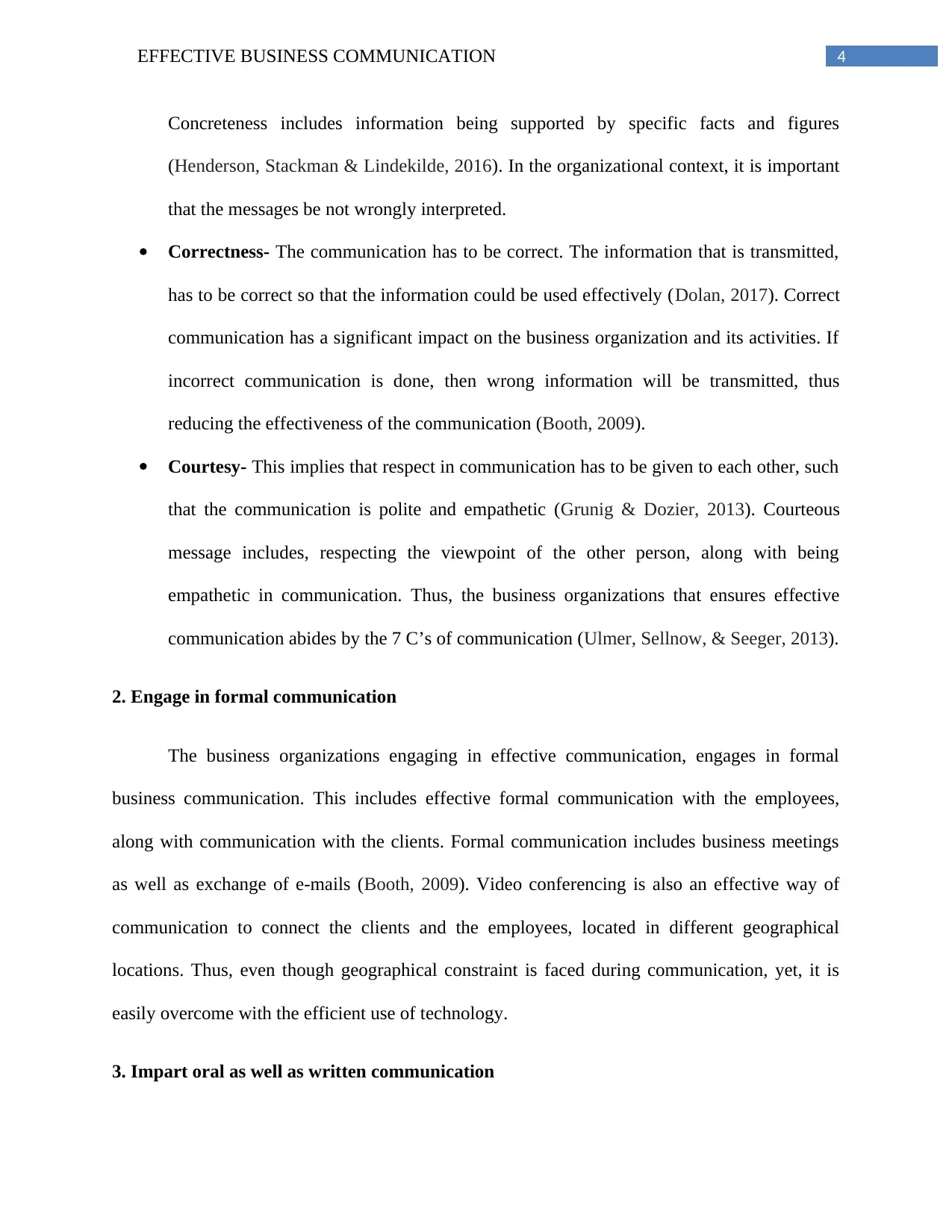
4EFFECTIVE BUSINESS COMMUNICATION
Concreteness includes information being supported by specific facts and figures
(Henderson, Stackman & Lindekilde, 2016). In the organizational context, it is important
that the messages be not wrongly interpreted.
Correctness- The communication has to be correct. The information that is transmitted,
has to be correct so that the information could be used effectively (Dolan, 2017). Correct
communication has a significant impact on the business organization and its activities. If
incorrect communication is done, then wrong information will be transmitted, thus
reducing the effectiveness of the communication (Booth, 2009).
Courtesy- This implies that respect in communication has to be given to each other, such
that the communication is polite and empathetic (Grunig & Dozier, 2013). Courteous
message includes, respecting the viewpoint of the other person, along with being
empathetic in communication. Thus, the business organizations that ensures effective
communication abides by the 7 C’s of communication (Ulmer, Sellnow, & Seeger, 2013).
2. Engage in formal communication
The business organizations engaging in effective communication, engages in formal
business communication. This includes effective formal communication with the employees,
along with communication with the clients. Formal communication includes business meetings
as well as exchange of e-mails (Booth, 2009). Video conferencing is also an effective way of
communication to connect the clients and the employees, located in different geographical
locations. Thus, even though geographical constraint is faced during communication, yet, it is
easily overcome with the efficient use of technology.
3. Impart oral as well as written communication
Concreteness includes information being supported by specific facts and figures
(Henderson, Stackman & Lindekilde, 2016). In the organizational context, it is important
that the messages be not wrongly interpreted.
Correctness- The communication has to be correct. The information that is transmitted,
has to be correct so that the information could be used effectively (Dolan, 2017). Correct
communication has a significant impact on the business organization and its activities. If
incorrect communication is done, then wrong information will be transmitted, thus
reducing the effectiveness of the communication (Booth, 2009).
Courtesy- This implies that respect in communication has to be given to each other, such
that the communication is polite and empathetic (Grunig & Dozier, 2013). Courteous
message includes, respecting the viewpoint of the other person, along with being
empathetic in communication. Thus, the business organizations that ensures effective
communication abides by the 7 C’s of communication (Ulmer, Sellnow, & Seeger, 2013).
2. Engage in formal communication
The business organizations engaging in effective communication, engages in formal
business communication. This includes effective formal communication with the employees,
along with communication with the clients. Formal communication includes business meetings
as well as exchange of e-mails (Booth, 2009). Video conferencing is also an effective way of
communication to connect the clients and the employees, located in different geographical
locations. Thus, even though geographical constraint is faced during communication, yet, it is
easily overcome with the efficient use of technology.
3. Impart oral as well as written communication
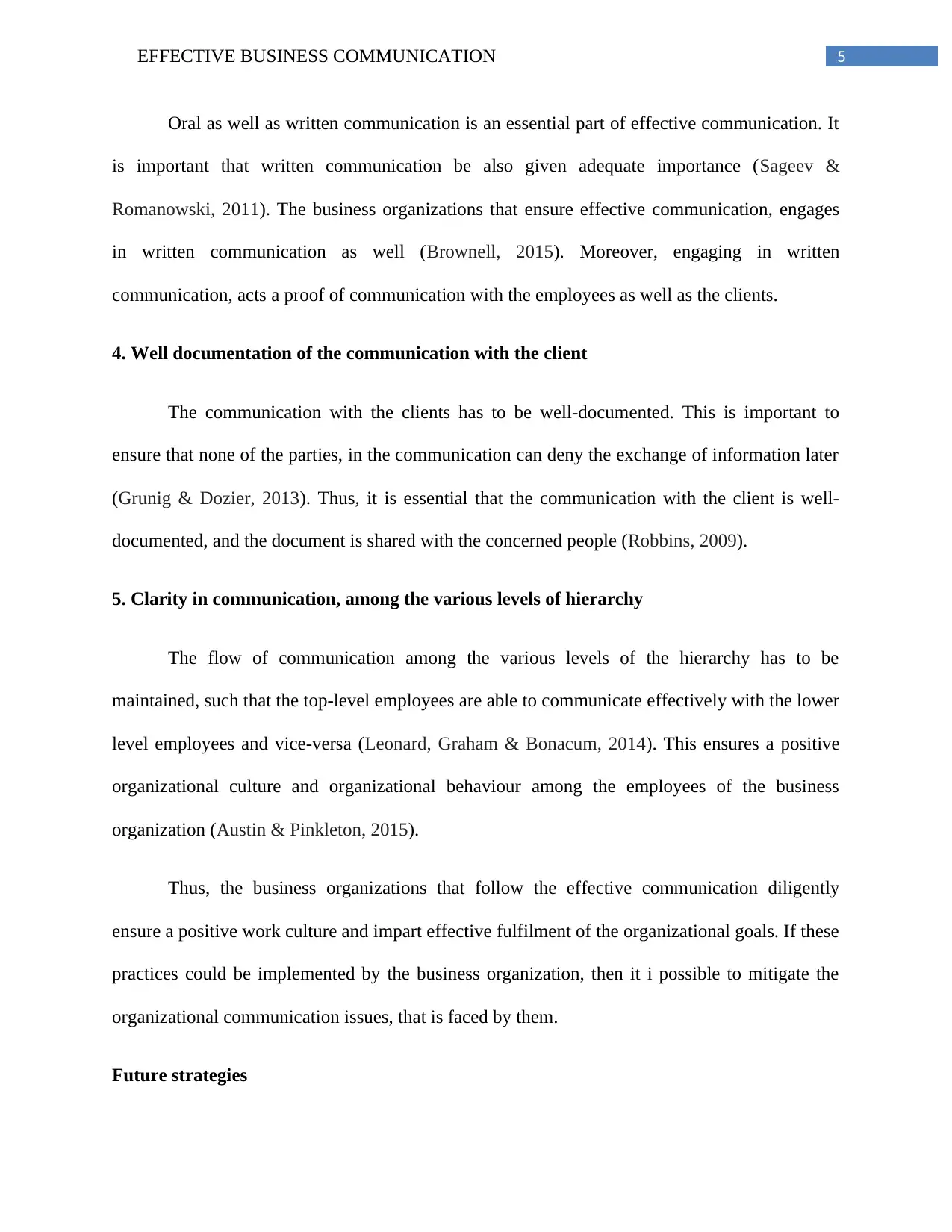
5EFFECTIVE BUSINESS COMMUNICATION
Oral as well as written communication is an essential part of effective communication. It
is important that written communication be also given adequate importance (Sageev &
Romanowski, 2011). The business organizations that ensure effective communication, engages
in written communication as well (Brownell, 2015). Moreover, engaging in written
communication, acts a proof of communication with the employees as well as the clients.
4. Well documentation of the communication with the client
The communication with the clients has to be well-documented. This is important to
ensure that none of the parties, in the communication can deny the exchange of information later
(Grunig & Dozier, 2013). Thus, it is essential that the communication with the client is well-
documented, and the document is shared with the concerned people (Robbins, 2009).
5. Clarity in communication, among the various levels of hierarchy
The flow of communication among the various levels of the hierarchy has to be
maintained, such that the top-level employees are able to communicate effectively with the lower
level employees and vice-versa (Leonard, Graham & Bonacum, 2014). This ensures a positive
organizational culture and organizational behaviour among the employees of the business
organization (Austin & Pinkleton, 2015).
Thus, the business organizations that follow the effective communication diligently
ensure a positive work culture and impart effective fulfilment of the organizational goals. If these
practices could be implemented by the business organization, then it i possible to mitigate the
organizational communication issues, that is faced by them.
Future strategies
Oral as well as written communication is an essential part of effective communication. It
is important that written communication be also given adequate importance (Sageev &
Romanowski, 2011). The business organizations that ensure effective communication, engages
in written communication as well (Brownell, 2015). Moreover, engaging in written
communication, acts a proof of communication with the employees as well as the clients.
4. Well documentation of the communication with the client
The communication with the clients has to be well-documented. This is important to
ensure that none of the parties, in the communication can deny the exchange of information later
(Grunig & Dozier, 2013). Thus, it is essential that the communication with the client is well-
documented, and the document is shared with the concerned people (Robbins, 2009).
5. Clarity in communication, among the various levels of hierarchy
The flow of communication among the various levels of the hierarchy has to be
maintained, such that the top-level employees are able to communicate effectively with the lower
level employees and vice-versa (Leonard, Graham & Bonacum, 2014). This ensures a positive
organizational culture and organizational behaviour among the employees of the business
organization (Austin & Pinkleton, 2015).
Thus, the business organizations that follow the effective communication diligently
ensure a positive work culture and impart effective fulfilment of the organizational goals. If these
practices could be implemented by the business organization, then it i possible to mitigate the
organizational communication issues, that is faced by them.
Future strategies
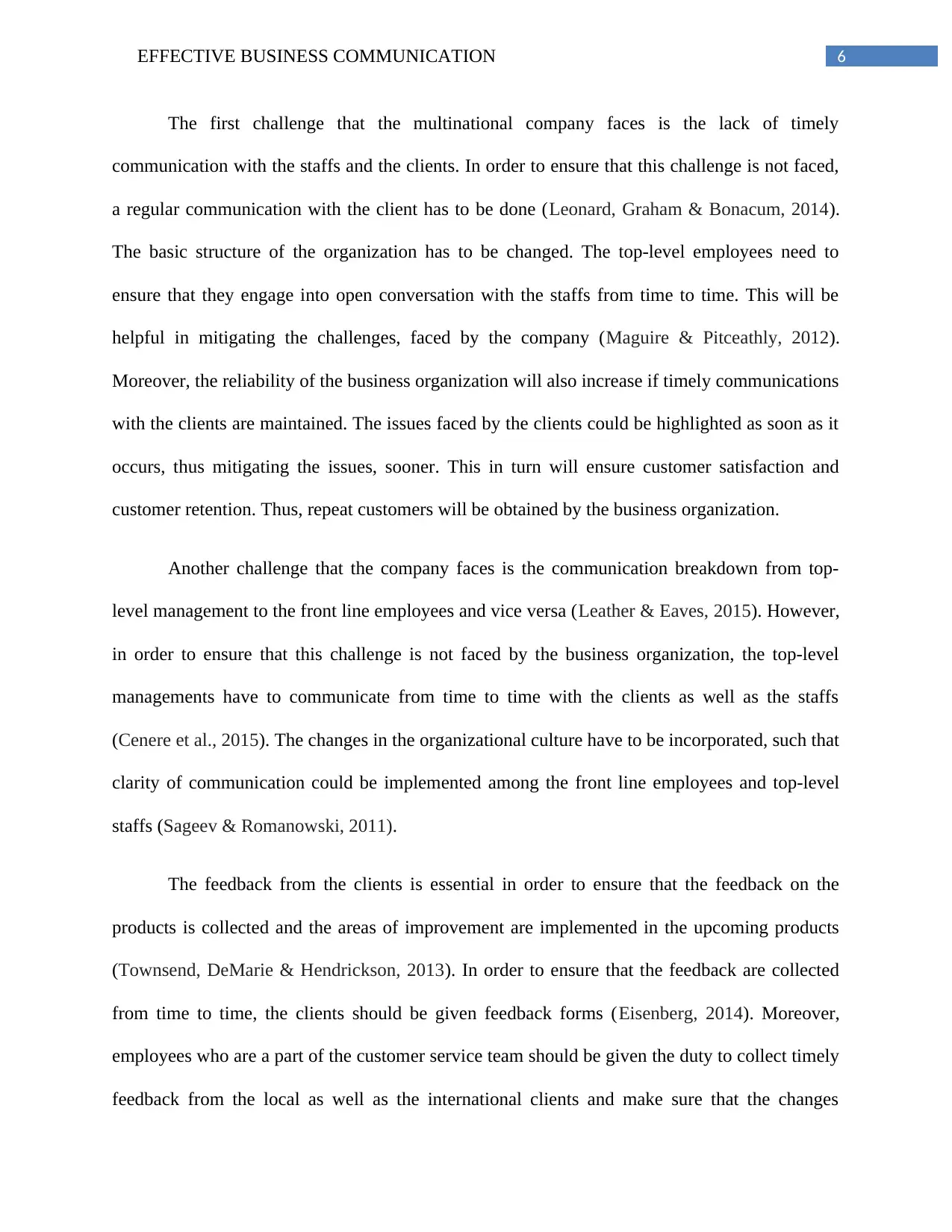
6EFFECTIVE BUSINESS COMMUNICATION
The first challenge that the multinational company faces is the lack of timely
communication with the staffs and the clients. In order to ensure that this challenge is not faced,
a regular communication with the client has to be done (Leonard, Graham & Bonacum, 2014).
The basic structure of the organization has to be changed. The top-level employees need to
ensure that they engage into open conversation with the staffs from time to time. This will be
helpful in mitigating the challenges, faced by the company (Maguire & Pitceathly, 2012).
Moreover, the reliability of the business organization will also increase if timely communications
with the clients are maintained. The issues faced by the clients could be highlighted as soon as it
occurs, thus mitigating the issues, sooner. This in turn will ensure customer satisfaction and
customer retention. Thus, repeat customers will be obtained by the business organization.
Another challenge that the company faces is the communication breakdown from top-
level management to the front line employees and vice versa (Leather & Eaves, 2015). However,
in order to ensure that this challenge is not faced by the business organization, the top-level
managements have to communicate from time to time with the clients as well as the staffs
(Cenere et al., 2015). The changes in the organizational culture have to be incorporated, such that
clarity of communication could be implemented among the front line employees and top-level
staffs (Sageev & Romanowski, 2011).
The feedback from the clients is essential in order to ensure that the feedback on the
products is collected and the areas of improvement are implemented in the upcoming products
(Townsend, DeMarie & Hendrickson, 2013). In order to ensure that the feedback are collected
from time to time, the clients should be given feedback forms (Eisenberg, 2014). Moreover,
employees who are a part of the customer service team should be given the duty to collect timely
feedback from the local as well as the international clients and make sure that the changes
The first challenge that the multinational company faces is the lack of timely
communication with the staffs and the clients. In order to ensure that this challenge is not faced,
a regular communication with the client has to be done (Leonard, Graham & Bonacum, 2014).
The basic structure of the organization has to be changed. The top-level employees need to
ensure that they engage into open conversation with the staffs from time to time. This will be
helpful in mitigating the challenges, faced by the company (Maguire & Pitceathly, 2012).
Moreover, the reliability of the business organization will also increase if timely communications
with the clients are maintained. The issues faced by the clients could be highlighted as soon as it
occurs, thus mitigating the issues, sooner. This in turn will ensure customer satisfaction and
customer retention. Thus, repeat customers will be obtained by the business organization.
Another challenge that the company faces is the communication breakdown from top-
level management to the front line employees and vice versa (Leather & Eaves, 2015). However,
in order to ensure that this challenge is not faced by the business organization, the top-level
managements have to communicate from time to time with the clients as well as the staffs
(Cenere et al., 2015). The changes in the organizational culture have to be incorporated, such that
clarity of communication could be implemented among the front line employees and top-level
staffs (Sageev & Romanowski, 2011).
The feedback from the clients is essential in order to ensure that the feedback on the
products is collected and the areas of improvement are implemented in the upcoming products
(Townsend, DeMarie & Hendrickson, 2013). In order to ensure that the feedback are collected
from time to time, the clients should be given feedback forms (Eisenberg, 2014). Moreover,
employees who are a part of the customer service team should be given the duty to collect timely
feedback from the local as well as the international clients and make sure that the changes
Paraphrase This Document
Need a fresh take? Get an instant paraphrase of this document with our AI Paraphraser
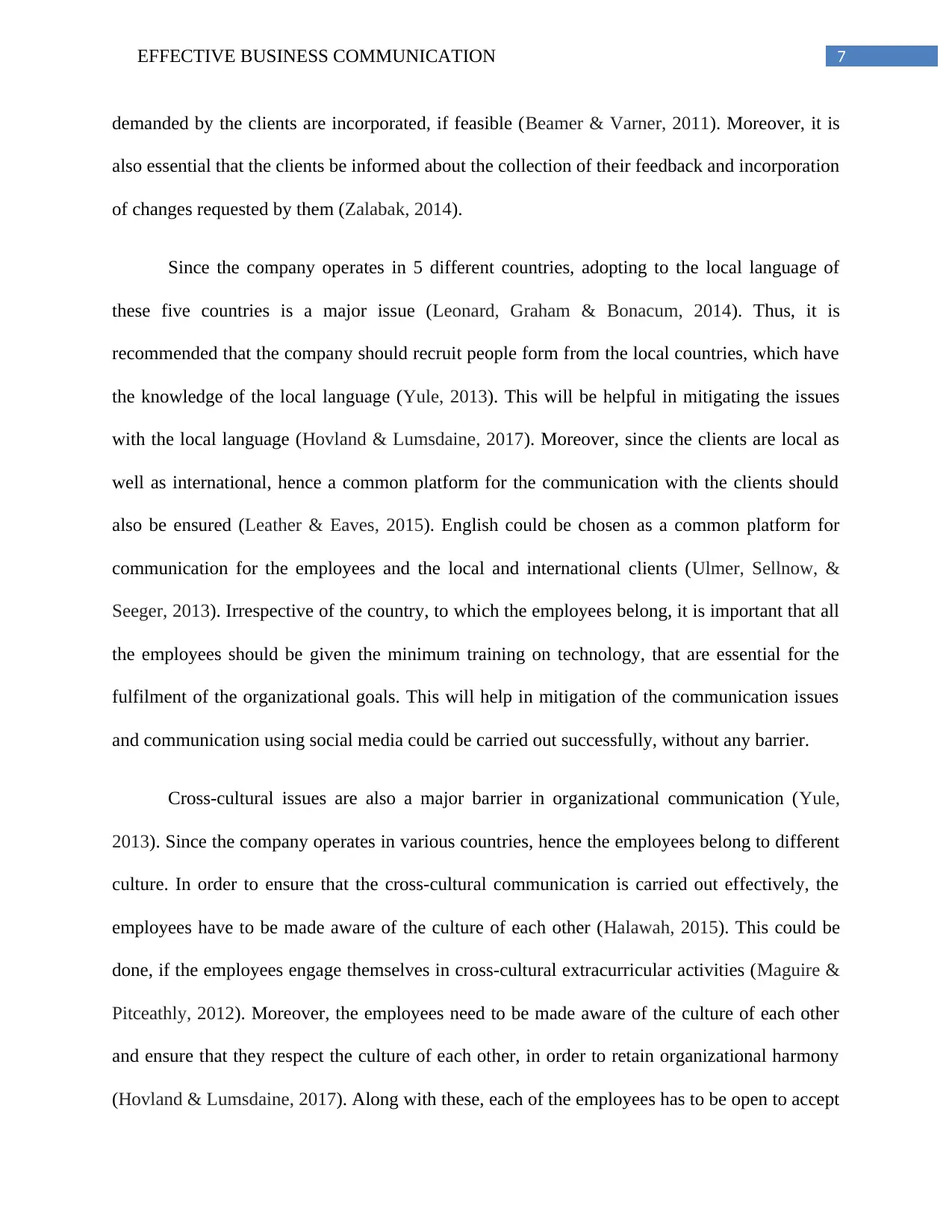
7EFFECTIVE BUSINESS COMMUNICATION
demanded by the clients are incorporated, if feasible (Beamer & Varner, 2011). Moreover, it is
also essential that the clients be informed about the collection of their feedback and incorporation
of changes requested by them (Zalabak, 2014).
Since the company operates in 5 different countries, adopting to the local language of
these five countries is a major issue (Leonard, Graham & Bonacum, 2014). Thus, it is
recommended that the company should recruit people form from the local countries, which have
the knowledge of the local language (Yule, 2013). This will be helpful in mitigating the issues
with the local language (Hovland & Lumsdaine, 2017). Moreover, since the clients are local as
well as international, hence a common platform for the communication with the clients should
also be ensured (Leather & Eaves, 2015). English could be chosen as a common platform for
communication for the employees and the local and international clients (Ulmer, Sellnow, &
Seeger, 2013). Irrespective of the country, to which the employees belong, it is important that all
the employees should be given the minimum training on technology, that are essential for the
fulfilment of the organizational goals. This will help in mitigation of the communication issues
and communication using social media could be carried out successfully, without any barrier.
Cross-cultural issues are also a major barrier in organizational communication (Yule,
2013). Since the company operates in various countries, hence the employees belong to different
culture. In order to ensure that the cross-cultural communication is carried out effectively, the
employees have to be made aware of the culture of each other (Halawah, 2015). This could be
done, if the employees engage themselves in cross-cultural extracurricular activities (Maguire &
Pitceathly, 2012). Moreover, the employees need to be made aware of the culture of each other
and ensure that they respect the culture of each other, in order to retain organizational harmony
(Hovland & Lumsdaine, 2017). Along with these, each of the employees has to be open to accept
demanded by the clients are incorporated, if feasible (Beamer & Varner, 2011). Moreover, it is
also essential that the clients be informed about the collection of their feedback and incorporation
of changes requested by them (Zalabak, 2014).
Since the company operates in 5 different countries, adopting to the local language of
these five countries is a major issue (Leonard, Graham & Bonacum, 2014). Thus, it is
recommended that the company should recruit people form from the local countries, which have
the knowledge of the local language (Yule, 2013). This will be helpful in mitigating the issues
with the local language (Hovland & Lumsdaine, 2017). Moreover, since the clients are local as
well as international, hence a common platform for the communication with the clients should
also be ensured (Leather & Eaves, 2015). English could be chosen as a common platform for
communication for the employees and the local and international clients (Ulmer, Sellnow, &
Seeger, 2013). Irrespective of the country, to which the employees belong, it is important that all
the employees should be given the minimum training on technology, that are essential for the
fulfilment of the organizational goals. This will help in mitigation of the communication issues
and communication using social media could be carried out successfully, without any barrier.
Cross-cultural issues are also a major barrier in organizational communication (Yule,
2013). Since the company operates in various countries, hence the employees belong to different
culture. In order to ensure that the cross-cultural communication is carried out effectively, the
employees have to be made aware of the culture of each other (Halawah, 2015). This could be
done, if the employees engage themselves in cross-cultural extracurricular activities (Maguire &
Pitceathly, 2012). Moreover, the employees need to be made aware of the culture of each other
and ensure that they respect the culture of each other, in order to retain organizational harmony
(Hovland & Lumsdaine, 2017). Along with these, each of the employees has to be open to accept
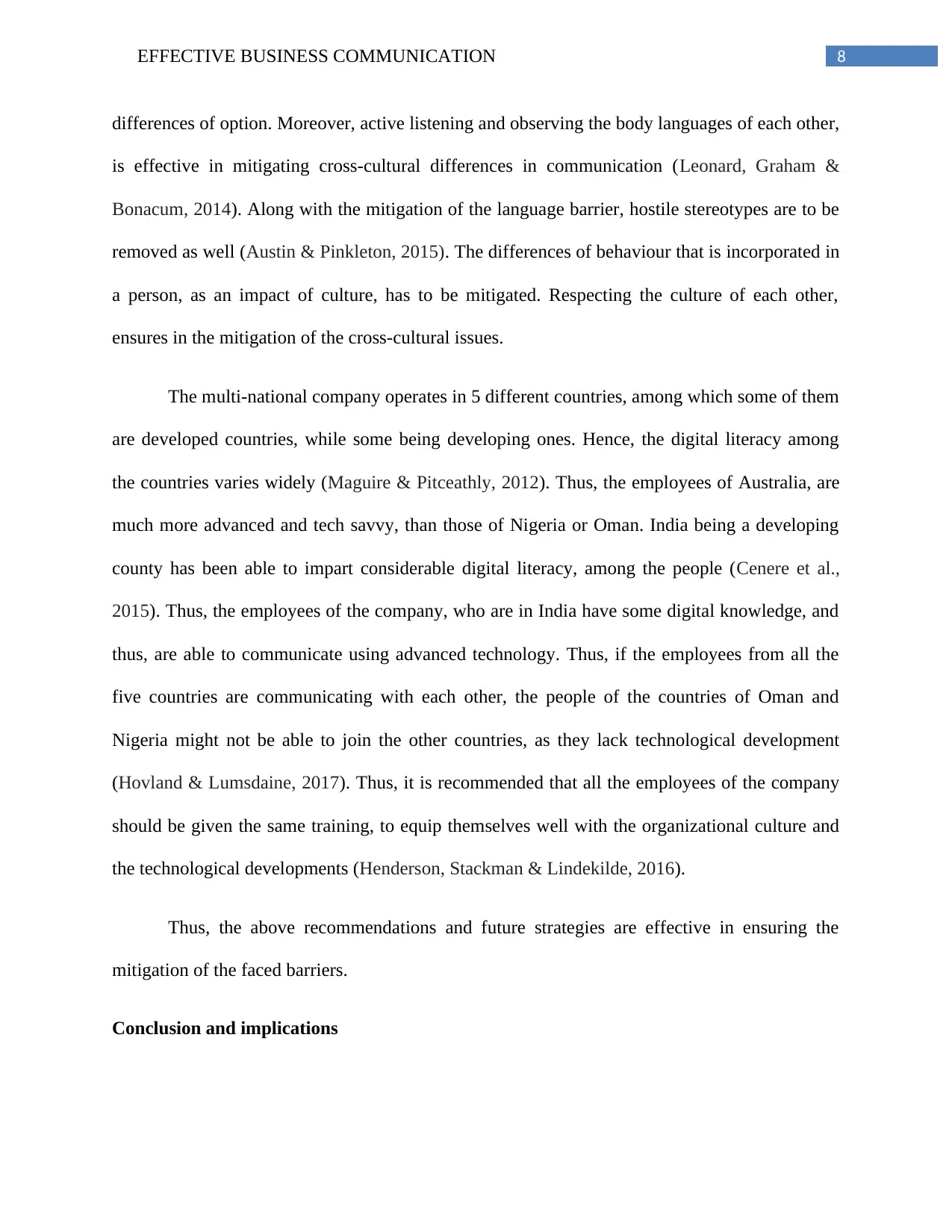
8EFFECTIVE BUSINESS COMMUNICATION
differences of option. Moreover, active listening and observing the body languages of each other,
is effective in mitigating cross-cultural differences in communication (Leonard, Graham &
Bonacum, 2014). Along with the mitigation of the language barrier, hostile stereotypes are to be
removed as well (Austin & Pinkleton, 2015). The differences of behaviour that is incorporated in
a person, as an impact of culture, has to be mitigated. Respecting the culture of each other,
ensures in the mitigation of the cross-cultural issues.
The multi-national company operates in 5 different countries, among which some of them
are developed countries, while some being developing ones. Hence, the digital literacy among
the countries varies widely (Maguire & Pitceathly, 2012). Thus, the employees of Australia, are
much more advanced and tech savvy, than those of Nigeria or Oman. India being a developing
county has been able to impart considerable digital literacy, among the people (Cenere et al.,
2015). Thus, the employees of the company, who are in India have some digital knowledge, and
thus, are able to communicate using advanced technology. Thus, if the employees from all the
five countries are communicating with each other, the people of the countries of Oman and
Nigeria might not be able to join the other countries, as they lack technological development
(Hovland & Lumsdaine, 2017). Thus, it is recommended that all the employees of the company
should be given the same training, to equip themselves well with the organizational culture and
the technological developments (Henderson, Stackman & Lindekilde, 2016).
Thus, the above recommendations and future strategies are effective in ensuring the
mitigation of the faced barriers.
Conclusion and implications
differences of option. Moreover, active listening and observing the body languages of each other,
is effective in mitigating cross-cultural differences in communication (Leonard, Graham &
Bonacum, 2014). Along with the mitigation of the language barrier, hostile stereotypes are to be
removed as well (Austin & Pinkleton, 2015). The differences of behaviour that is incorporated in
a person, as an impact of culture, has to be mitigated. Respecting the culture of each other,
ensures in the mitigation of the cross-cultural issues.
The multi-national company operates in 5 different countries, among which some of them
are developed countries, while some being developing ones. Hence, the digital literacy among
the countries varies widely (Maguire & Pitceathly, 2012). Thus, the employees of Australia, are
much more advanced and tech savvy, than those of Nigeria or Oman. India being a developing
county has been able to impart considerable digital literacy, among the people (Cenere et al.,
2015). Thus, the employees of the company, who are in India have some digital knowledge, and
thus, are able to communicate using advanced technology. Thus, if the employees from all the
five countries are communicating with each other, the people of the countries of Oman and
Nigeria might not be able to join the other countries, as they lack technological development
(Hovland & Lumsdaine, 2017). Thus, it is recommended that all the employees of the company
should be given the same training, to equip themselves well with the organizational culture and
the technological developments (Henderson, Stackman & Lindekilde, 2016).
Thus, the above recommendations and future strategies are effective in ensuring the
mitigation of the faced barriers.
Conclusion and implications
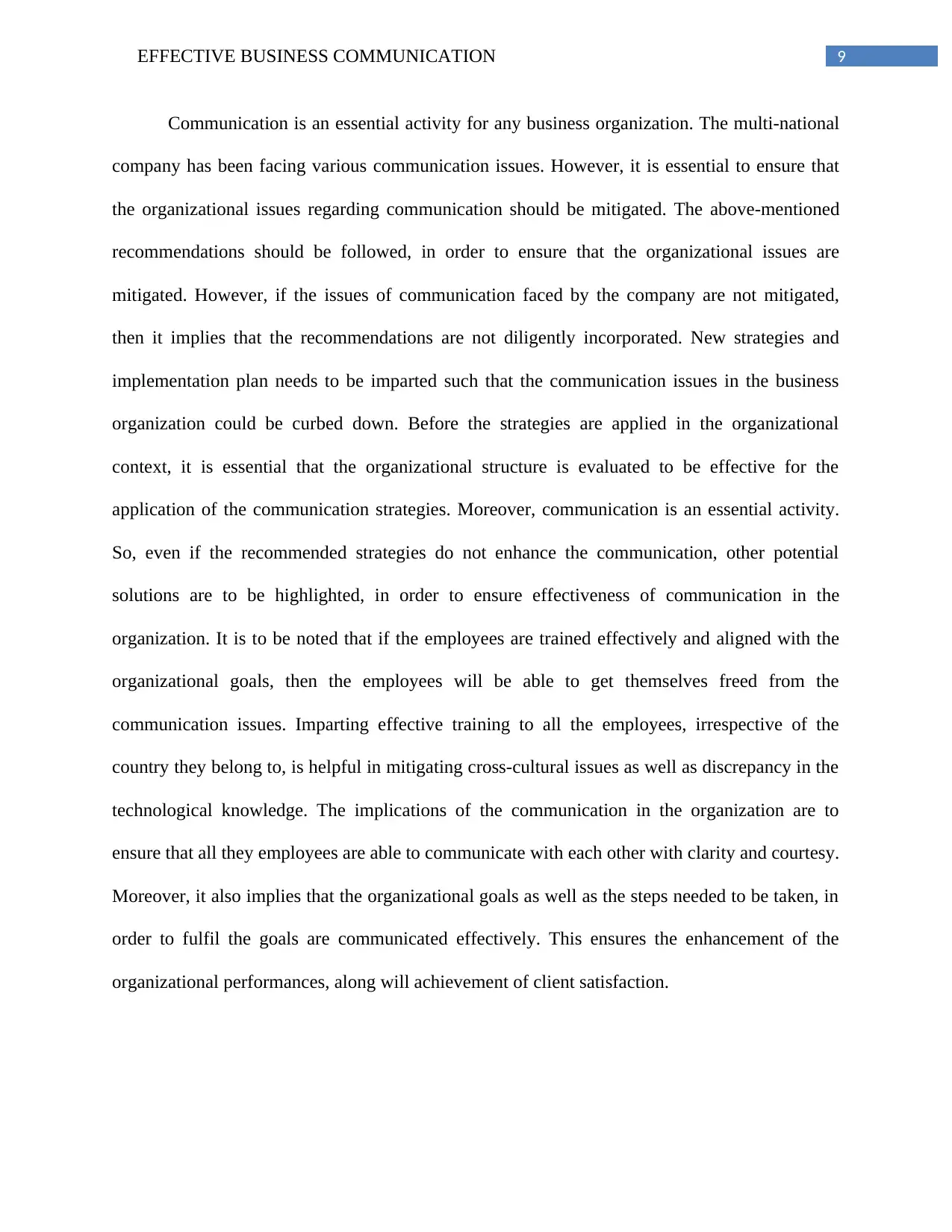
9EFFECTIVE BUSINESS COMMUNICATION
Communication is an essential activity for any business organization. The multi-national
company has been facing various communication issues. However, it is essential to ensure that
the organizational issues regarding communication should be mitigated. The above-mentioned
recommendations should be followed, in order to ensure that the organizational issues are
mitigated. However, if the issues of communication faced by the company are not mitigated,
then it implies that the recommendations are not diligently incorporated. New strategies and
implementation plan needs to be imparted such that the communication issues in the business
organization could be curbed down. Before the strategies are applied in the organizational
context, it is essential that the organizational structure is evaluated to be effective for the
application of the communication strategies. Moreover, communication is an essential activity.
So, even if the recommended strategies do not enhance the communication, other potential
solutions are to be highlighted, in order to ensure effectiveness of communication in the
organization. It is to be noted that if the employees are trained effectively and aligned with the
organizational goals, then the employees will be able to get themselves freed from the
communication issues. Imparting effective training to all the employees, irrespective of the
country they belong to, is helpful in mitigating cross-cultural issues as well as discrepancy in the
technological knowledge. The implications of the communication in the organization are to
ensure that all they employees are able to communicate with each other with clarity and courtesy.
Moreover, it also implies that the organizational goals as well as the steps needed to be taken, in
order to fulfil the goals are communicated effectively. This ensures the enhancement of the
organizational performances, along will achievement of client satisfaction.
Communication is an essential activity for any business organization. The multi-national
company has been facing various communication issues. However, it is essential to ensure that
the organizational issues regarding communication should be mitigated. The above-mentioned
recommendations should be followed, in order to ensure that the organizational issues are
mitigated. However, if the issues of communication faced by the company are not mitigated,
then it implies that the recommendations are not diligently incorporated. New strategies and
implementation plan needs to be imparted such that the communication issues in the business
organization could be curbed down. Before the strategies are applied in the organizational
context, it is essential that the organizational structure is evaluated to be effective for the
application of the communication strategies. Moreover, communication is an essential activity.
So, even if the recommended strategies do not enhance the communication, other potential
solutions are to be highlighted, in order to ensure effectiveness of communication in the
organization. It is to be noted that if the employees are trained effectively and aligned with the
organizational goals, then the employees will be able to get themselves freed from the
communication issues. Imparting effective training to all the employees, irrespective of the
country they belong to, is helpful in mitigating cross-cultural issues as well as discrepancy in the
technological knowledge. The implications of the communication in the organization are to
ensure that all they employees are able to communicate with each other with clarity and courtesy.
Moreover, it also implies that the organizational goals as well as the steps needed to be taken, in
order to fulfil the goals are communicated effectively. This ensures the enhancement of the
organizational performances, along will achievement of client satisfaction.
Secure Best Marks with AI Grader
Need help grading? Try our AI Grader for instant feedback on your assignments.
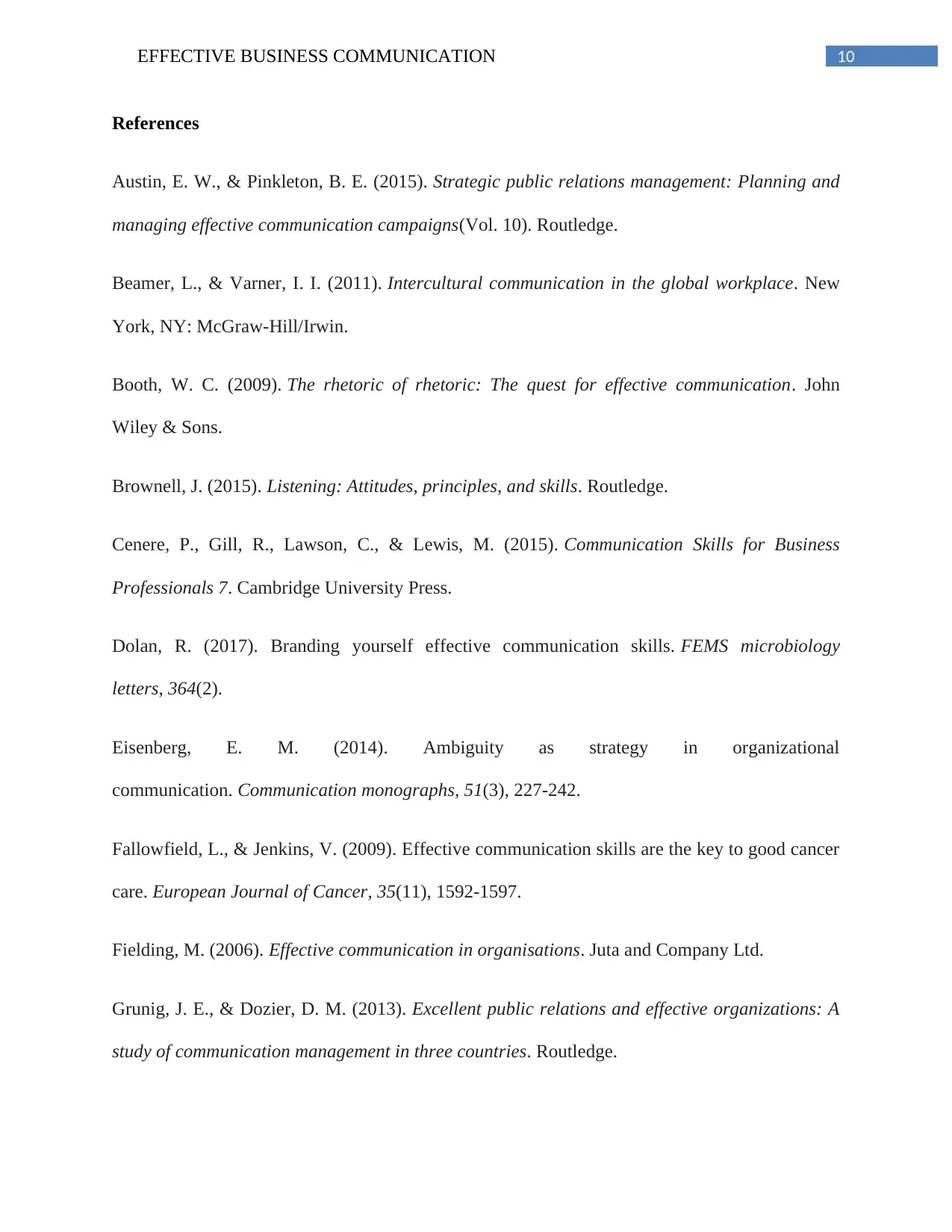
10EFFECTIVE BUSINESS COMMUNICATION
References
Austin, E. W., & Pinkleton, B. E. (2015). Strategic public relations management: Planning and
managing effective communication campaigns(Vol. 10). Routledge.
Beamer, L., & Varner, I. I. (2011). Intercultural communication in the global workplace. New
York, NY: McGraw-Hill/Irwin.
Booth, W. C. (2009). The rhetoric of rhetoric: The quest for effective communication. John
Wiley & Sons.
Brownell, J. (2015). Listening: Attitudes, principles, and skills. Routledge.
Cenere, P., Gill, R., Lawson, C., & Lewis, M. (2015). Communication Skills for Business
Professionals 7. Cambridge University Press.
Dolan, R. (2017). Branding yourself effective communication skills. FEMS microbiology
letters, 364(2).
Eisenberg, E. M. (2014). Ambiguity as strategy in organizational
communication. Communication monographs, 51(3), 227-242.
Fallowfield, L., & Jenkins, V. (2009). Effective communication skills are the key to good cancer
care. European Journal of Cancer, 35(11), 1592-1597.
Fielding, M. (2006). Effective communication in organisations. Juta and Company Ltd.
Grunig, J. E., & Dozier, D. M. (2013). Excellent public relations and effective organizations: A
study of communication management in three countries. Routledge.
References
Austin, E. W., & Pinkleton, B. E. (2015). Strategic public relations management: Planning and
managing effective communication campaigns(Vol. 10). Routledge.
Beamer, L., & Varner, I. I. (2011). Intercultural communication in the global workplace. New
York, NY: McGraw-Hill/Irwin.
Booth, W. C. (2009). The rhetoric of rhetoric: The quest for effective communication. John
Wiley & Sons.
Brownell, J. (2015). Listening: Attitudes, principles, and skills. Routledge.
Cenere, P., Gill, R., Lawson, C., & Lewis, M. (2015). Communication Skills for Business
Professionals 7. Cambridge University Press.
Dolan, R. (2017). Branding yourself effective communication skills. FEMS microbiology
letters, 364(2).
Eisenberg, E. M. (2014). Ambiguity as strategy in organizational
communication. Communication monographs, 51(3), 227-242.
Fallowfield, L., & Jenkins, V. (2009). Effective communication skills are the key to good cancer
care. European Journal of Cancer, 35(11), 1592-1597.
Fielding, M. (2006). Effective communication in organisations. Juta and Company Ltd.
Grunig, J. E., & Dozier, D. M. (2013). Excellent public relations and effective organizations: A
study of communication management in three countries. Routledge.
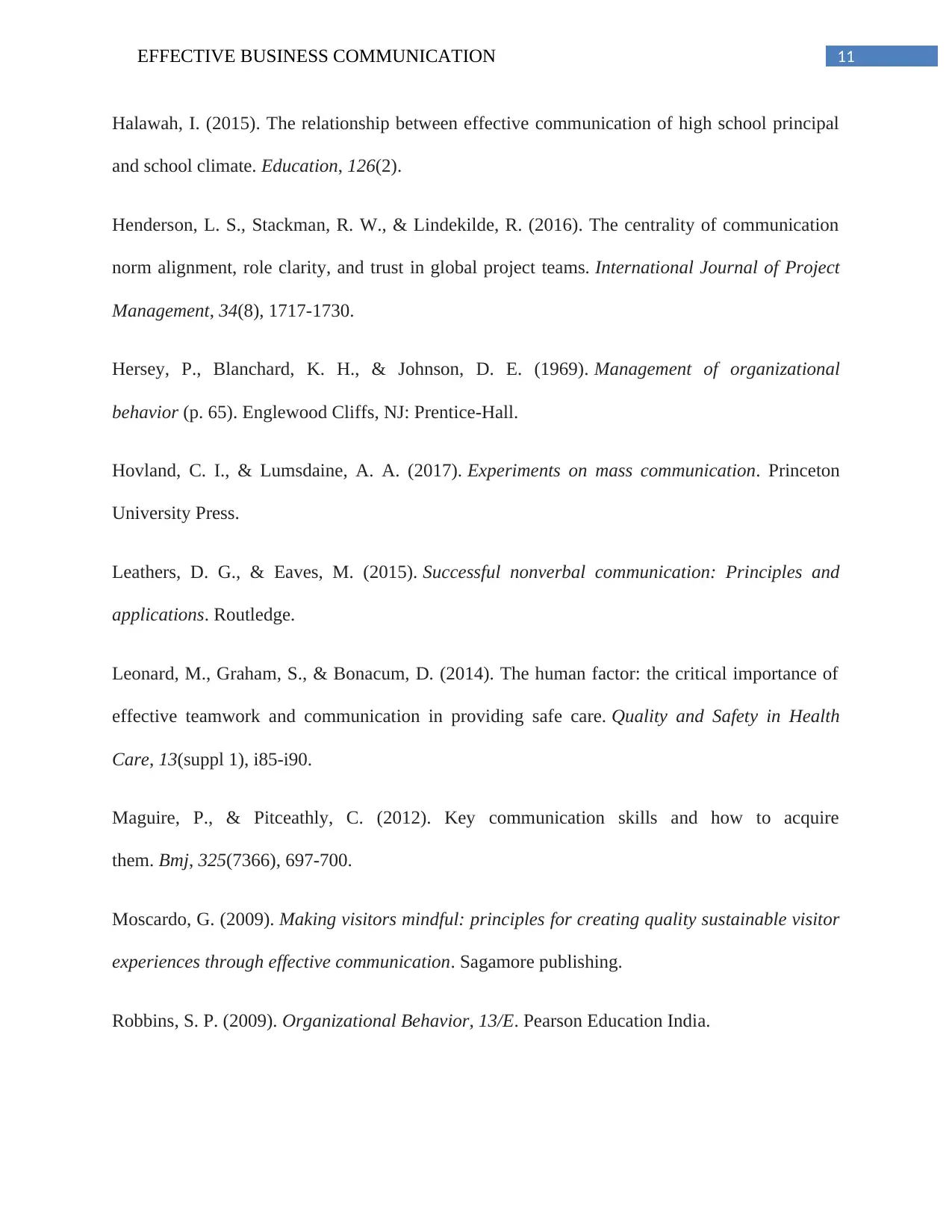
11EFFECTIVE BUSINESS COMMUNICATION
Halawah, I. (2015). The relationship between effective communication of high school principal
and school climate. Education, 126(2).
Henderson, L. S., Stackman, R. W., & Lindekilde, R. (2016). The centrality of communication
norm alignment, role clarity, and trust in global project teams. International Journal of Project
Management, 34(8), 1717-1730.
Hersey, P., Blanchard, K. H., & Johnson, D. E. (1969). Management of organizational
behavior (p. 65). Englewood Cliffs, NJ: Prentice-Hall.
Hovland, C. I., & Lumsdaine, A. A. (2017). Experiments on mass communication. Princeton
University Press.
Leathers, D. G., & Eaves, M. (2015). Successful nonverbal communication: Principles and
applications. Routledge.
Leonard, M., Graham, S., & Bonacum, D. (2014). The human factor: the critical importance of
effective teamwork and communication in providing safe care. Quality and Safety in Health
Care, 13(suppl 1), i85-i90.
Maguire, P., & Pitceathly, C. (2012). Key communication skills and how to acquire
them. Bmj, 325(7366), 697-700.
Moscardo, G. (2009). Making visitors mindful: principles for creating quality sustainable visitor
experiences through effective communication. Sagamore publishing.
Robbins, S. P. (2009). Organizational Behavior, 13/E. Pearson Education India.
Halawah, I. (2015). The relationship between effective communication of high school principal
and school climate. Education, 126(2).
Henderson, L. S., Stackman, R. W., & Lindekilde, R. (2016). The centrality of communication
norm alignment, role clarity, and trust in global project teams. International Journal of Project
Management, 34(8), 1717-1730.
Hersey, P., Blanchard, K. H., & Johnson, D. E. (1969). Management of organizational
behavior (p. 65). Englewood Cliffs, NJ: Prentice-Hall.
Hovland, C. I., & Lumsdaine, A. A. (2017). Experiments on mass communication. Princeton
University Press.
Leathers, D. G., & Eaves, M. (2015). Successful nonverbal communication: Principles and
applications. Routledge.
Leonard, M., Graham, S., & Bonacum, D. (2014). The human factor: the critical importance of
effective teamwork and communication in providing safe care. Quality and Safety in Health
Care, 13(suppl 1), i85-i90.
Maguire, P., & Pitceathly, C. (2012). Key communication skills and how to acquire
them. Bmj, 325(7366), 697-700.
Moscardo, G. (2009). Making visitors mindful: principles for creating quality sustainable visitor
experiences through effective communication. Sagamore publishing.
Robbins, S. P. (2009). Organizational Behavior, 13/E. Pearson Education India.
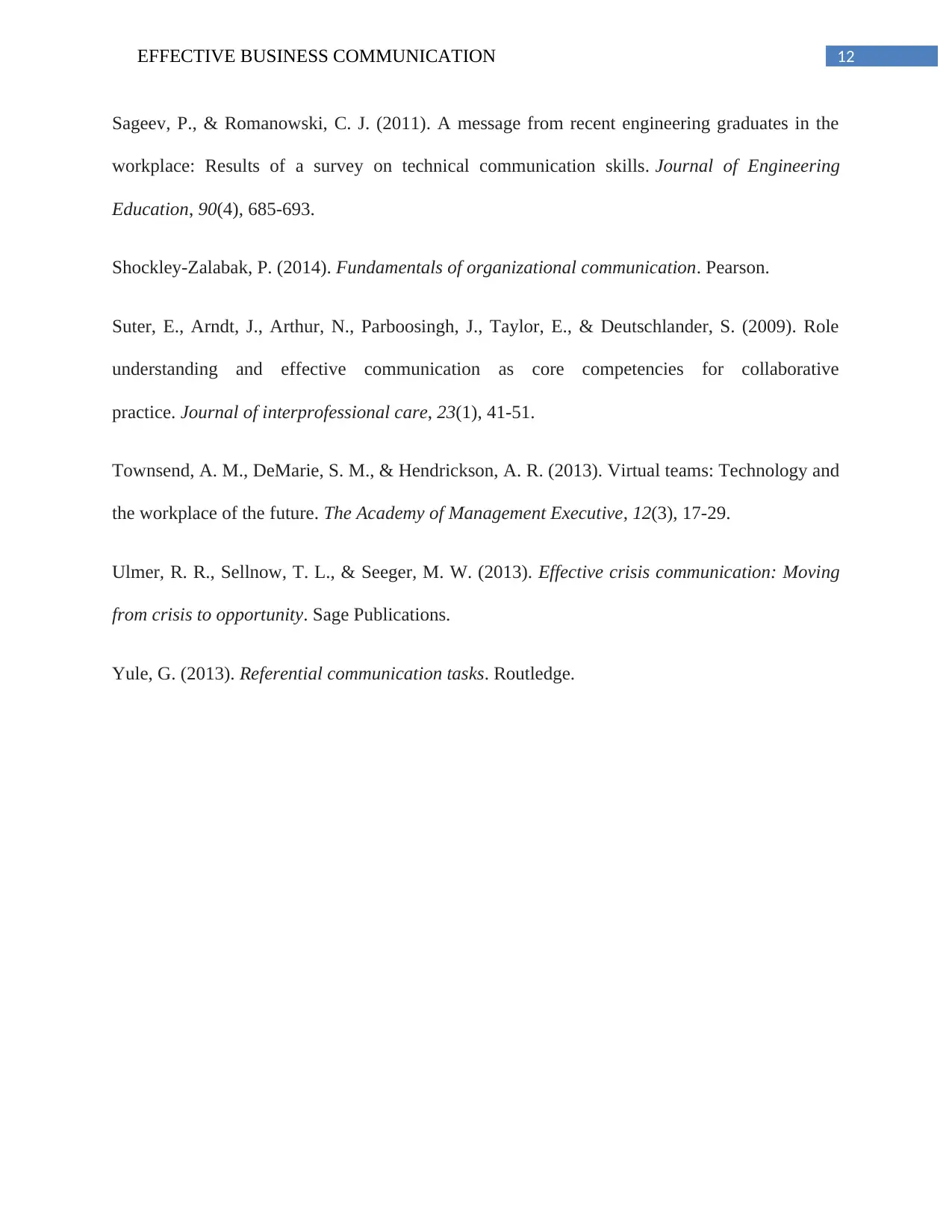
12EFFECTIVE BUSINESS COMMUNICATION
Sageev, P., & Romanowski, C. J. (2011). A message from recent engineering graduates in the
workplace: Results of a survey on technical communication skills. Journal of Engineering
Education, 90(4), 685-693.
Shockley-Zalabak, P. (2014). Fundamentals of organizational communication. Pearson.
Suter, E., Arndt, J., Arthur, N., Parboosingh, J., Taylor, E., & Deutschlander, S. (2009). Role
understanding and effective communication as core competencies for collaborative
practice. Journal of interprofessional care, 23(1), 41-51.
Townsend, A. M., DeMarie, S. M., & Hendrickson, A. R. (2013). Virtual teams: Technology and
the workplace of the future. The Academy of Management Executive, 12(3), 17-29.
Ulmer, R. R., Sellnow, T. L., & Seeger, M. W. (2013). Effective crisis communication: Moving
from crisis to opportunity. Sage Publications.
Yule, G. (2013). Referential communication tasks. Routledge.
Sageev, P., & Romanowski, C. J. (2011). A message from recent engineering graduates in the
workplace: Results of a survey on technical communication skills. Journal of Engineering
Education, 90(4), 685-693.
Shockley-Zalabak, P. (2014). Fundamentals of organizational communication. Pearson.
Suter, E., Arndt, J., Arthur, N., Parboosingh, J., Taylor, E., & Deutschlander, S. (2009). Role
understanding and effective communication as core competencies for collaborative
practice. Journal of interprofessional care, 23(1), 41-51.
Townsend, A. M., DeMarie, S. M., & Hendrickson, A. R. (2013). Virtual teams: Technology and
the workplace of the future. The Academy of Management Executive, 12(3), 17-29.
Ulmer, R. R., Sellnow, T. L., & Seeger, M. W. (2013). Effective crisis communication: Moving
from crisis to opportunity. Sage Publications.
Yule, G. (2013). Referential communication tasks. Routledge.
1 out of 13
Related Documents
Your All-in-One AI-Powered Toolkit for Academic Success.
+13062052269
info@desklib.com
Available 24*7 on WhatsApp / Email
![[object Object]](/_next/static/media/star-bottom.7253800d.svg)
Unlock your academic potential
© 2024 | Zucol Services PVT LTD | All rights reserved.





